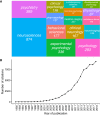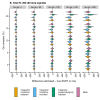A consensus guide to capturing the ability to inhibit actions and impulsive behaviors in the stop-signal task
- PMID: 31033438
- PMCID: PMC6533084
- DOI: 10.7554/eLife.46323
A consensus guide to capturing the ability to inhibit actions and impulsive behaviors in the stop-signal task
Abstract
Response inhibition is essential for navigating everyday life. Its derailment is considered integral to numerous neurological and psychiatric disorders, and more generally, to a wide range of behavioral and health problems. Response-inhibition efficiency furthermore correlates with treatment outcome in some of these conditions. The stop-signal task is an essential tool to determine how quickly response inhibition is implemented. Despite its apparent simplicity, there are many features (ranging from task design to data analysis) that vary across studies in ways that can easily compromise the validity of the obtained results. Our goal is to facilitate a more accurate use of the stop-signal task. To this end, we provide 12 easy-to-implement consensus recommendations and point out the problems that can arise when they are not followed. Furthermore, we provide user-friendly open-source resources intended to inform statistical-power considerations, facilitate the correct implementation of the task, and assist in proper data analysis.
Keywords: countermanding; human; human biology; impulse control; impulsivity; medicine; mouse; neuroscience; race model; rat; response inhibition; rhesus macaque; stop-signal task.
© 2019, Verbruggen et al.
Conflict of interest statement
FV, GB, PB, AB, JB, CC, HC, LC, BC, JC, AD, DE, HG, IG, AH, RH, SJ, JK, IL, CL, GL, DM, SM, AM, MP, RP, KR, MR, JS, AS, KT, Mv, LV, MV, JW, RW, BZ, CB No competing interests declared, AA, NS Reviewing editor, eLife, CB has received payment for consulting and speaker's honoraria from GlaxoSmithKline, Novartis, Genzyme, and Teva. He has recent research grants with Novartis and Genzyme, SC consults for Shire, Ieso Digital Health, Cambridge Cognition, and Promentis. Dr Chamberlain's research is funded by Wellcome Trust (110049/Z/15/Z), TR consults for Cambridge Cognition, Mundipharma and Unilever. He receives royalties from Cambridge Cognition (CANTAB) and has recent research grants with Shionogi and SmallPharma, KR has received speaker's honoraria and grants for other projects from Eli Lilly and Shire, RS has consulted to Highland Therapeutics, Eli Lilly and Co., and Purdue Pharma. He has commercial interest in a cognitive rehabilitation software company, eHave
Figures










References
Publication types
MeSH terms
Grants and funding
LinkOut - more resources
Full Text Sources
Other Literature Sources
Medical

